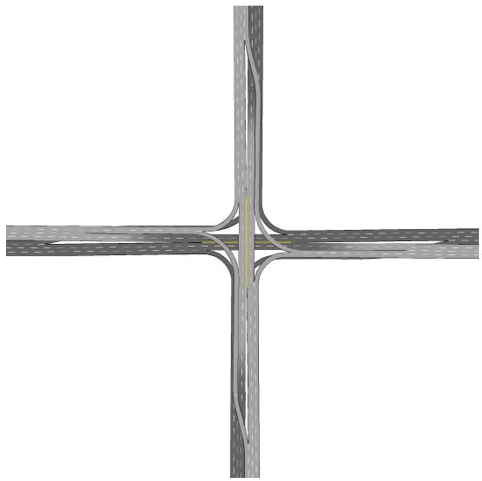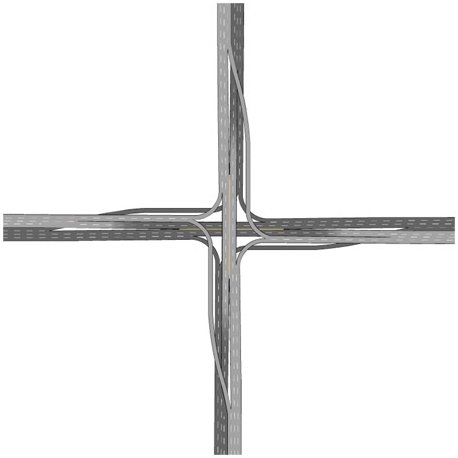 |
|
| |
|
- It is a concave non-stop interchange with
left turn and right turn ramps are the connecting points on the
main road.
- It is a two-level interchange with possible left and right turns
without signals, while it takes up the minimum amount of area for
non-stop interchange.
- Left turns are made from the left lane, and right turns are made
from the right lane, and this is the same for all 4 directions.
However, there is no point of conflict resulting from merging of
traffic traveling to different directions. There are only split
offs and merges.
- Since roads merge after they split off to the left and right
from the main road, there is no point of conflict as seen in the
cloverleaf interchange.
- It can be applied in urban areas because it requires nearly the
similar area as the conventional intersection. |
|
| |
|
 |
|
| |
|
| - In most of the Non-Stop Interchanges in use today, the left and
right turn only lanes are convex to the main roads they connect. |
|
| |
|
| - This type of interchange requires a significantly large area.
(Refer to photograph on right) Such interchange cannot easily be used
in urban areas due to the space it requires. |
|
| |
|
| - Furthermore, points of conflict between vehicles between vehicles
taking the off ramp and the main traffic as well as merging vehicles
and the main traffic, which pose threats of accident. |
|
| |
|
| - Increasing the conflict area to reduce the possibility of accidents
is one of the reasons the interchange requires larger area. |
|
| |
|
|
|
| |
|
 |
|
| |
|
| - The Non-Stop Interchange by Roadnext has been developed for urban
roads. |
|
| |
|
 |
|
 |
|
| |
|
| - “Interchange 1” requires no more space than the conventional intersection.
“Interchange 1” has a total of 8 lanes, 4 lanes in each direction. |
|
| |
|
| - The right turn only ramp makes the right turn from the right side
of the road. |
|
| |
|
| - Left turn only ramp does not go outside the main road or the right
turn only ramp. |
|
| |
|
| - For example, a left turn from south to west, it splits off to
the left, overpasses the 3rd and 4th lanes of the opposite traffic
and makes a left loop over the east-west main road to finally merge
with the 3rd lane of the east-west main road. |
|
| |
|
| - What appears to be traffic island on the top and bottom roads
actually take place over and below the main roads, so the area it
requires is not more than the conventional intersection. |
|
| |
|
| - If the left turn ramps from all directions (total of 4) are placed
on the outside the main road for easier understanding of “Interchange
1” it takes the shape of "Interchange 2." (Left turn ramp
from east to south and from west to north are hidden from view by
the top road on "Interchange 1.") |
|
| |
|
| - In other words, “Interchange 1” is essentially a design that requires
less area for left turn ramps than “Interchange 2.” |
|
| |
|
 |
|
 |
|
| |
|
| - It requires no more area than the conventional intersection, as
the points of connection with left turn and right turn only ramps. |
|
| |
|
| - Like the conventional intersection, it follows the natural flow
of traffic convention of left turn from left lane and right turn from
right lane. |
|
| |
|
| - Since it is a non-stop interchange, each lane can handle as much
traffic as 2 or 3 lanes of the conventional intersection. |
|
| |
|
| - The left and right turn off ramps and merges of interchange can
be applied flexibly depending on the road condition. Flexible application
includes that it can be designed with turn only lanes or tapered type
of lanes. |
|
| |
|
 |
|

